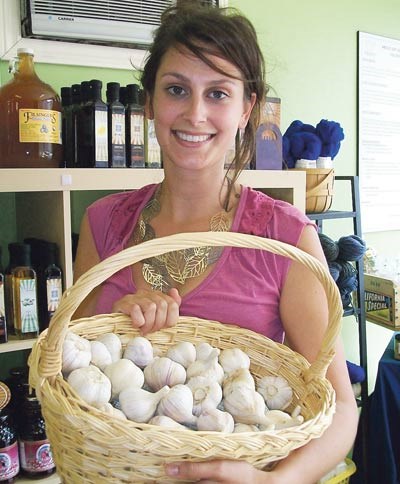With a recently-released report showing that Canadians are eating more than twice as much sodium (or salt) as they should, Jessica Nadel has a few ideas about how people can reduce their salt intake.
The marketing and education intern at the Eat Local Sudbury Co-operative said when people make an effort to eat locally-produced foods, such as those sold by her organization, they start out with more “whole” foods which have no added salt.
“By doing that, you have more control over what sort of seasonings you’re using, and how much salt you’re putting in, as opposed to frozen meals, takeout, or eating out at restaurants,” Nadel said.
“That’s why restaurant food is so delicious. There’s lots of oil, butter and a ton of salt.”
She suggests that people use other types of seasonings, such as garlic, as an alternative to salt. Fresh, local produce is also more flavourful, and doesn’t need as much seasoning, she said.
However, cooking from scratch takes time and requires some skills in the kitchen. Nadel figures this may be the root of why people eat so much salt-laden convenience food.

Definitely read the food labels. That’s the most important thing we can do right now as individuals.
Lesley Andrade,
public health nutritionist, Sudbury and District Health Unit
“Everything is moving faster,” she said. “We try to fit as much in as we possibly can. We’re working more, and we’re doing more...and a lot of people don’t necessarily know how to cook the way we used to.”
In late 2007, the federal Ministry of Health established a Sodium Working Group comprised of food manufacturing and food service industry groups, health groups, scientists, consumer advocacy groups, health professionals and government.
The group released a report late last month called the Sodium Reduction Strategy for Canada, which makes a number of recommendations to the government.
According to the report, on average, Canadians consume about 3,400 milligrams of sodium per day.
The report sets a goal of reducing that intake to an average of 2,300 milligrams per day by 2016, and eventually reducing it even lower. An adequate sodium intake for adults is 1,500 milligrams, while the upper limit is 2,300 milligrams.
The report suggests a three-pronged approach to achieving this goal — structured, voluntary reduction of sodium levels in processed food products and foods sold in restaurants and food service establishments; education and awareness for consumers, industry and health professionals; and support for research.
Lesley Andrade, a public health nutritionist with the Sudbury and District Health Unit, said there are many health risks associated with consuming too much salt.
“There’s a link to high blood pressure,” she said. “High blood pressure is a major cause of cardiovascular disease and also a risk factor for stroke and kidney disease.
“The report also mentioned that there is evidence showing that a diet high in sodium is also a risk factor for osteoporosis, stomach cancer and asthma.”
Andrade said high salt levels are not only found in fast food and convenience food, but in everyday staples such as bread and cheese. In fact, 77 per cent of the salt we eat comes from processed foods, she said.
For this reason, it’s extremely important to get the food industry on board, she said. Consumers should contact the food industry, and demand that they reduce the salt in their products.
The Food and Consumer Products of Canada (FCPC), which represents food and consumer product manufacturers in the country, put out a press release July 29 saying voluntary salt reduction in food products is the right approach to take. “Our members are committed to offering a variety of healthy products,” Phyllis Tanaka, vice president, scientific and regulatory affairs, food policy, with FCPC, said in a press release.
“For many years they have been developing new products with reduced sodium and reformulating processed food products to reduce their sodium levels, and will continue to make advances in doing so. But it’s important for Canadians to know that lowering sodium to the interim target level set by the Working Group is uncharted territory for the industry, so it is going to take time.”
Like Nadel, Andrade suggests that people looking to reduce their salt intake buy unprocessed foods and prepare it themselves so they can control the amount of salt added. For example, instead of buying a rotisserie chicken prepared in the grocery store, buy a chicken from the meat section, and roast it in the oven, she said.
As well, once you’re sitting at the dinner table, resist the urge to sprinkle on more salt, Andrade said. Those who don’t have much time to cook can also take steps to reduce the salt they consume, she said.
“Definitely read the food labels,” Andrade said.
“That’s the most important thing we can do right now as individuals.”
She said there’s also a provincially-run program called Eat Right Ontario, which allows citizens to contact a dietitian with their questions. For more information, go to www.eatrightontario.ca or phone 1-877-510-5102.
To read more about the Sodium Reduction Strategy for Canada report, go to www.hc-sc.gc.ca and search for “sodium reduction strategy.”
People can visit the Eat Local Sudbury Co-operative on the weekends at Market Square, or at the organization’s store, located at 176 Larch Street.
For more information phone 521-6717 or go to www.eatlocalsudbury.com or www.sdhu.com.
